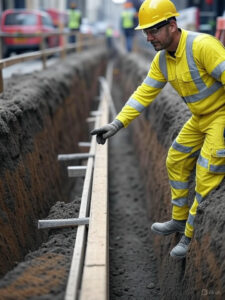Trenching and excavation work may be common on construction sites—but that doesn’t make it any less dangerous. In fact, trenching is one of the most hazardous construction activities, with cave-ins posing the deadliest risk.
Whether you’re installing utilities, repairing sewer lines, or working roadside infrastructure, understanding trench safety is critical to protecting yourself and others.
The Real Risks of Trenching
Every year, over 5,000 workers suffer serious injuries, and more than 100 lives are lost to trench-related accidents in the U.S. A cave-in can happen suddenly and without warning, crushing anyone inside with thousands of pounds of soil.
Even on small-scale projects, serious hazards exist:
Common Trenching Hazards:
-
Cave-ins from unstable soil, nearby equipment vibration, or heavy loads too close to the edge.
-
Hazardous atmospheres from released toxic gases or low oxygen levels.
-
Underground utilities that pose electrical, gas, or water hazards if struck.
Know the Soil—Know the Danger
Soil might look harmless, but it can weigh over 2,700 pounds per cubic yard—more than a small car. OSHA classifies soil into four categories:
-
Solid Rock (most stable)
-
Type A
-
Type B
-
Type C (least stable)
If you’re not sure, assume it’s Type C and treat it with maximum caution. Also, make sure excavated soil is kept at least 2 feet away from the trench edge.
Who’s Responsible?
Under OSHA regulations, a competent person must inspect all trenches daily for:
-
Signs of a possible cave-in
-
Protective system failure
-
Hazardous atmospheres
-
Other unsafe conditions
For full OSHA guidelines, visit OSHA.gov.
Stay Protected with the Right Systems
OSHA mandates protective systems for trenches deeper than 5 feet, and an engineered plan for those deeper than 20 feet. These include:
-
Shoring and Sheeting
-
Shielding (e.g., trench boxes)
-
Sloping and Benching
It’s up to your team’s planners and on-site safety personnel to select the right method based on soil, trench depth, and site conditions.
Don’t Forget Access and Egress
For trenches over 4 feet deep, workers must have a safe way in and out—typically a ladder placed every 25 feet of horizontal travel.
Good planning saves lives. Before you dig, make sure your team is trained and prepared.
Using forklifts on your job site? Visit forklift.instructibly.com to access expert-guided safety courses. Knowledge is your best protection on the job.

